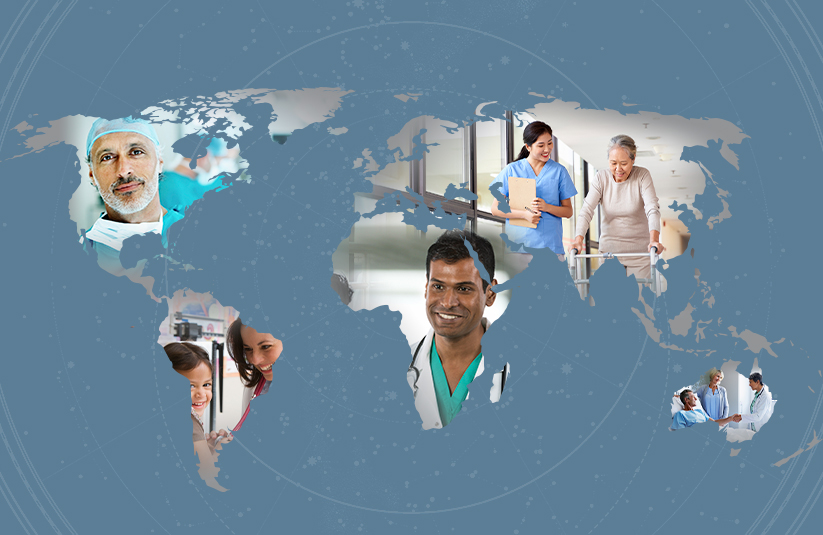
Many healthcare providers are drawn to their chosen field by a desire to help people and improve the lives of those around them. However, the everyday demands and administrative burdens placed on physicians can often detract from that meaning and purpose.
Karla Prentiss, Vice President of Sustainable Education and Development at International Medical Relief, works with healthcare providers to participate in short-term medical missions in areas of need around the globe. A common refrain she hears from physicians after they’ve completed an IMR medical mission is a feeling of reconnection to their love of medicine and patient care.
For healthcare providers considering their first — or repeat — medical mission, Prentiss offers these suggestions for preparing for a better, more enriching experience.
Tips for an enriching medical mission experience
A great medical mission experience is made up of a variety of factors that will be personal to whoever is going on that mission.
Select an organization whose mission resonates with you
“Often, people want to do good across the world and to feel like they are part of something bigger than themselves,” says Prentiss. “Many physicians I know want to feel like their investment of time and talent and treasure is going to carry on long after they’ve gone. They want to be part of something sustainable and something that grows, impacts, and increases the ability for the patients they’re treating to take better care of themselves by increasing health literacy.”
Does the organization facilitate patient referrals when mission trip ends?
An important factor for providers to consider is whether an organization has a strong process to triage patients into other areas of the clinic or the local healthcare infrastructure. The best medical mission organizations will facilitate access to these referral resources, which is key to helping manage patient care for chronic or long-term conditions.

“We don’t want to go in, take over for the local providers, uncover so much need, and not have a referral process in place to take care of those patients,” says Prentiss. “One thing I stress all the time is that we’re not trying to be anybody’s hero. What we’re trying to do is bring value to the local healthcare infrastructure — reconnecting to the roots of medicine, dealing with very primary care issues, and working with local healthcare providers on innovative solutions to bring care to their communities.”
Find an organization that emphasizes patient education for long-term success
In 2018, family medicine physician Dr. Maria Chansky participated in a medical mission to Haiti with Global Medical Staffing, funded by a Making a Difference Foundation grant. She emphasizes the importance of patient education as a key measure of long-term intervention.
“I think we make a difference in the short term. We treat sinus infections or skin infections, and I think that makes a difference for a while,” says Dr. Chansky. “But I think in the long term it’s the patient education that makes the biggest difference and is the most useful long-term intervention. Being at the displaced persons camps and seeing the huge line of patients waiting to be seen just spoke to the importance of what we were doing. I like serving people who need my help.”
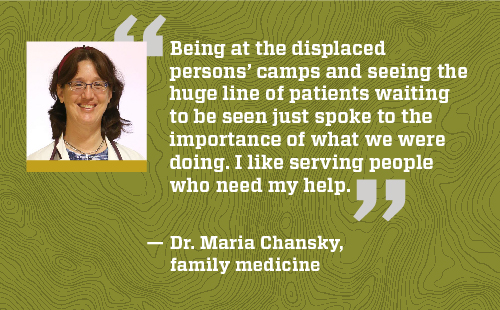
Characteristics for medical mission success
Some of the most important characteristics of a physician who is successful in a medical mission environment are compassion, empathy, and adaptability. Providers who thrive in a global setting are those who can adapt easily to a changing healthcare landscape.
“When providers come in with an open mind and an open heart, they can really direct what that experience is,” says Prentiss. “The physicians who go on our missions and seem to thrive are those who can adapt easily; are flexible; know and understand there’s a plan A, a plan B, a plan C every single day; and are comfortable functioning in that kind of environment.”
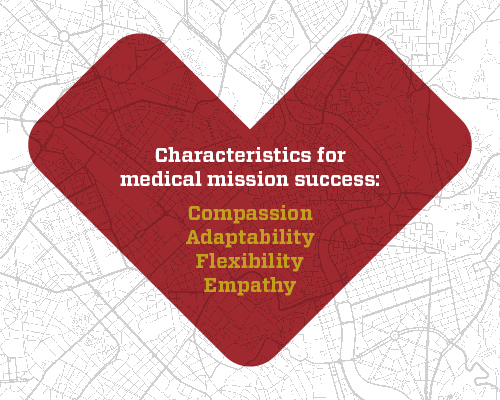
More on this topic: How other doctors use locum tenens to find balance and pursue their passions
Ideas to enhance your medical mission experience
Try to make meaningful connections
To make the most of one’s medical mission experience, Prentiss stresses the importance of making meaningful connections with the people around you.
“When providers feel connected to the culture or to a specific patient, their engagement and enjoyment of the experience are much higher,” says Prentiss. “We do our very best on every mission to ensure our providers feel and know their medical advice and consultation is making a difference to that patient.”
Focus on team connectedness and quality
The connectedness and quality of the team is another important factor that can enhance a provider’s medical mission experience. IMR medical missions establish diverse, multi-disciplinary teams from the international community to help elevate cultural competence and local understanding to enhance patient care.
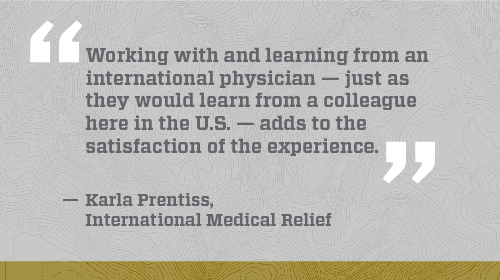
“We stand shoulder to shoulder with our international counterparts and bring in physicians from the international community to be part of the care team,” says Prentiss. “Working with and learning from an international physician — just as they would learn from a colleague here in the U.S. — adds to the satisfaction of the experience.”
Dr. Lynn Smith, a family practitioner who several years ago participated in a medical mission funded by a grant from the Making a Difference Foundation, speaks to the ways a connected team enriched his medical mission experience.
“I went with a diverse team of nearly 30 individuals. We were totally different. We’re different politically; we’re different in our experiences,” says Dr. Smith. “By the end of the trip, we all had something in common. We’d shared something special together, and we were friends. We’d given our time and talents and resources to help other people. That’s what makes these missions so special, and I love it so much.”
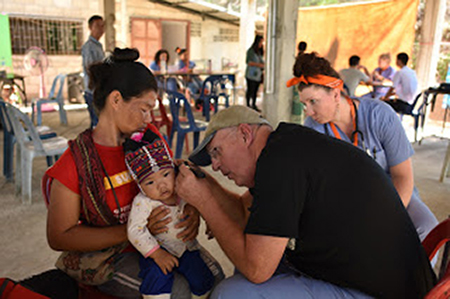
Bring your family along for a richer mission experience
“A lot of physicians work side by side with their children who are in medical school or with a spouse who has been by their side throughout their career,” says Prentiss. “It’s a gratifying way to reconnect on different levels — not just with the medical care they’re providing, but with other human beings.”
RELATED: Meet the providers who went on a medical mission to Thailand
Medical mission pitfalls to avoid
When it comes to watchouts, Prentiss cautions about the tendency to under-prepare, or even over-prepare.
“Providers are very busy, so sometimes they find themselves signing up for a medical mission, and before they know it, it’s a week away and they feel under-prepared,” says Prentiss. “Working with an established organization will give you access to resources to help you prepare.”
“On the other end of the spectrum, some physicians really get in their head about the complexity of the cases they expect they might see, and when they get into the field and realize it’s typically basic acute primary care, they may come away feeling disappointed,” says Prentiss. “Overthinking it and losing that sense of adventure can get one so far into the weeds that they can’t partake in the glorious beauty of humanity that is presented to them.”
Laying the groundwork for a future medical mission
Are you a provider interested in medical mission volunteer opportunities but for whom the timing isn’t quite right? There are many ways to become involved now to prepare yourself for a rewarding medical mission experience in the future.
“Some physicians are too busy with their current daily practice and patient loads, but they want to do medical mission work in the future,” says Prentiss. “There are many small steps they can take now to prepare, including serving on the board of a nonprofit that does global immersive work, learning about the cultural diversity in a country of interest, taking on international locum tenens work, getting involved with a medical mission organization and helping prepare others who are traveling, volunteering in a local resource-limited setting such as a homeless clinic, or providing care to those who are less fortunate within the confines of their local community.”
LEARN MORE: One physician’s decision to retire allowed him the time to pursue medical mission work
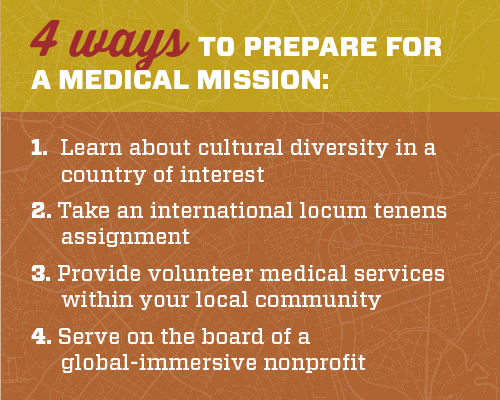
Advice for providers interested in a medical mission
For healthcare providers considering a medical mission, Prentiss offers the following advice:
- Research the organization to ensure the mission is well matched to your interests, skills, and passions
- Commit and then jump in with your whole heart
- Manage your expectations upfront; know and understand the goal and expected outcomes of the mission
- Go with an open mind and an open heart
- Look for small victories every da.
“Every night on our missions, we have a debrief and talk about who we interacted with that day. A lot of the moments we talk about are not about the care or the visit but about developing enduring friendships with their patients and their team. You may be partnered with a medical or dental student and share a piece of advice that’s going to change their life. Leave your baggage at home, and just come with a sense of adventure knowing you will impact someone’s life during the mission.”
Inspired to make a difference through a medical mission? The Making a Difference Foundation partners with world-class nonprofits to provide physicians the opportunity to participate in meaningful medical missions to make a difference around the globe.



 Back
Back